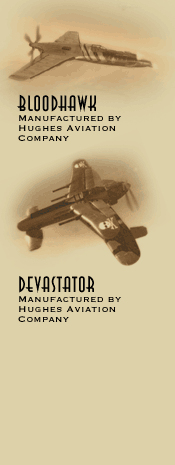
 |
||
 |
Founded by brilliant entrepreneur Howard Hughes -- a Texan who inherited his family’s oil fortune in 1924 -- Hughes Aviation has become one of the most innovative design houses and manufacturers of aircraft in North America. Hughes used his vast wealth to indulge in a number of his interests: by 1928, he was a major film producer, and soon was the toast of Hollywood society. A pilot since 1919, Hughes used some of the profits of his moviemaking ventures to fund the creation of Hughes Aviation, allowing him to indulge his other passion: flight. The first plane developed by Hughes Aviation was the Lancer, which set the world air-speed record at 352 m.p.h. a mere six days beofre the stock market crash. Hughes quickly moved to acquire resources and facilities from companies and individuals that did not fare as well in the Crash and the collapse of the United States, and built Hughes Aviation into a tremendous success. Today, Hughes Aviation is one of the best-known aircraft manufacturers in the world. This success has not been without cost, however. The flagship of Hughes Aviation’s fighter design group, the Bloodhawk is the focus of a bitter legal dispute with Bell Aircraft Corporation. In November of 1936, Dixie’s First Georgia Air Militia captured a squadron of Bloodhawks being shipped by air to a private client in the Empire State. The majority of the captured planes entered service with the First, but at least one appears to have reached the Bell plant at Marietta, where it became the subject of extensive examinations. Hughes quickly filed suit against Bell, but the Dixie company apparently expected the case to founder in the Confederacy’s legal system. They had not counted on Hughes’ determination. In March of 1937, Hughes Aviation Company acquired the Laister-Kauffman glider plant in St. Louis, which effectively granted Hughes the status of a Dixie corporation and circumvented the Confederacy’s protectionist policies. With their position badly undermined and legal costs spiraling out of control, Bell prepared for the worst. Then rescue came from an unexpected source: a partnership with Messerschmitt/General Motors. M/GM offered to bankroll Bell’s defense in exchange for access to the Bloodhawk research. The case is scheduled for trial in January, 1938. |
|
 |